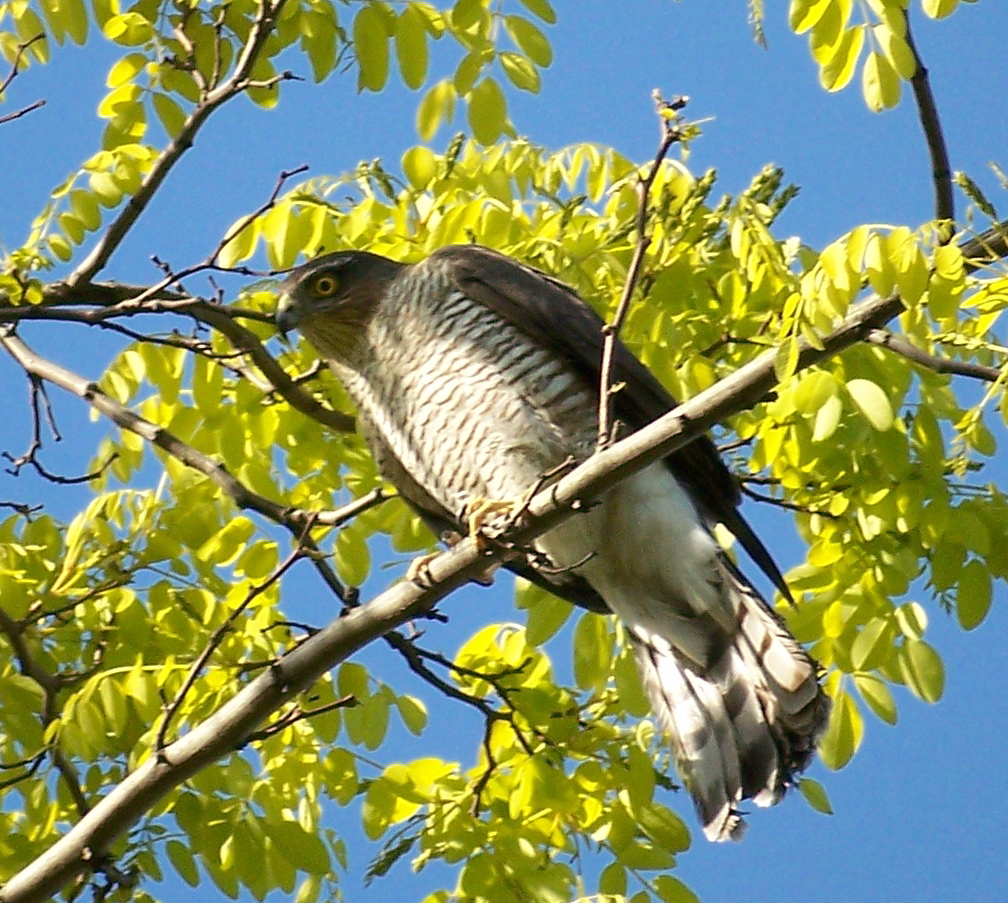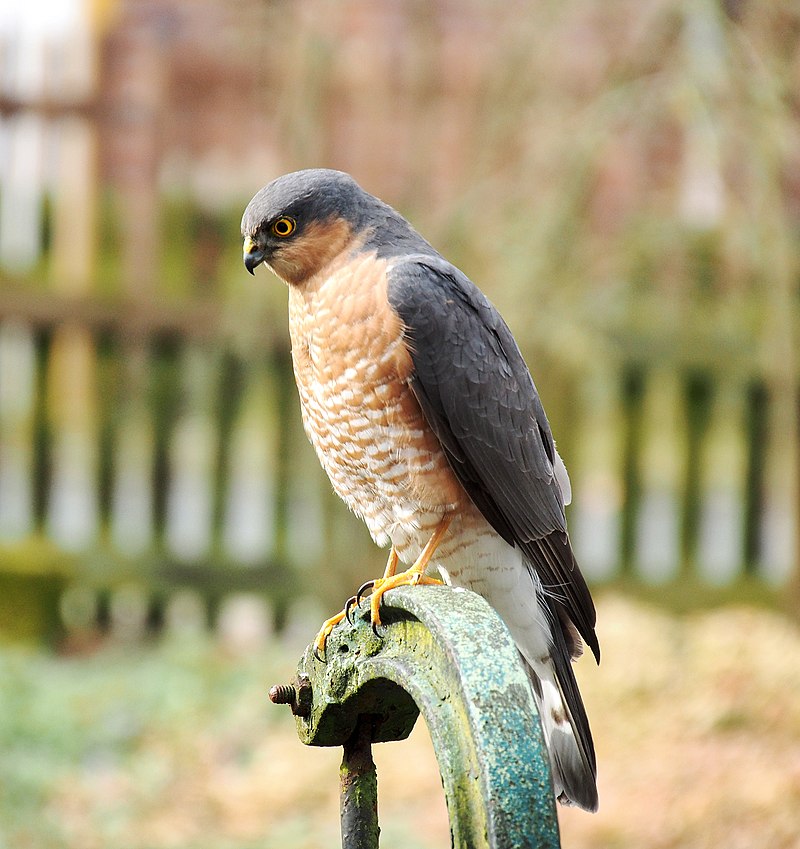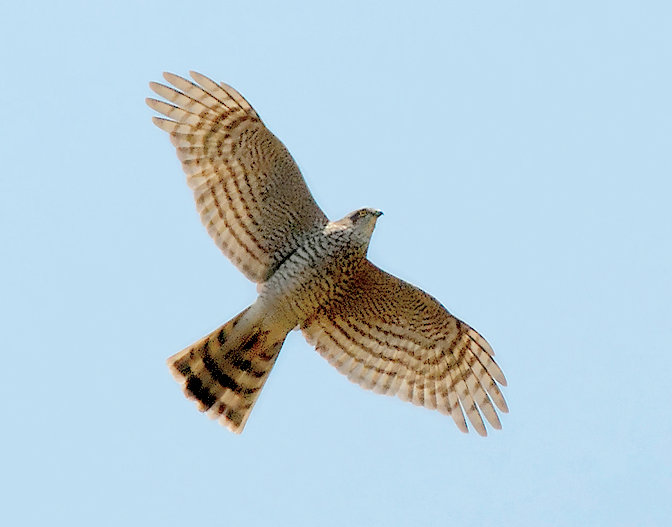Garden Wildlife
Garden Wildlife


What do they eat?
They are specialists on small to medium birds, caught on the wing. This contrasts with the kestrel, our commonest falcon, which concentrate on mouse-sized small mammals, and are rarely seen in gardens.
Where do they breed?
They breed from April to August with a single brood of up to 5 eggs each year. Mostly they nest in heavily wooded areas, but they do occasionally nest in large mature gardens. Their nest is an untidy mass of sticks with a deep central bowl.
What do they do?
Sparrowhawks hunt by chasing small birds in a fast and highly manoeuvrable flight. Any sparrowhawk you see hovering will actually be a kestrel! Females can tackle birds as big as a wood pigeon, males can take birds up to a blackbird in size. Only 10% of garden attacks are successful, and rarely seen by us, but a heap of feathers on the lawn is clear indication that they have visited.
How are they doing?
Found throughout Britain and Ireland, more common in lowlands. Their population more than doubled between 1975 and 1985, probably because of much reduced use of persistent pesticides, but declined by a third between 2005 and 2020, giving sparrowhawks Amber conservation status. Now estimated to be 31,000 pairs in Britain.
Finding out more:
Page written and compiled by Steve Head
Sparrowhawk Accipiter nisus
Woodland hawks which have adapted to farmland and suburban habitats and are the commonest urban predator species, recorded in about 10% of gardens.



Female bird Male bird
What do they look like?
The two sexes are markedly different in size, the male being 33cm long and weighing only 150g, while the female is 37cm long and weighs 260g.
Male sparrowhawks have dark slatey-grey back and head, reddish cheeks, and red-brown barred under-parts. The female has no red colouration and has smart grey-barred underparts and a prominent white line above the eye.
The flight silhouette shows short wide wings and a wedge-shaped tail.
Sophie Neill, XC604388. Accessible at www.xeno-canto.org/604388.
Jarek Matusiak, XC420205. Accessible at www.xeno-canto.org/420205.
Dawid Jablonski, XC580319. Accessible at www.xeno-canto.org/580319.
What do they sound like?
Repeated “keeow”call, and rapid “kek-kek-kek” alarm call. Juveniles beg with a pleading whistle.
Basic call Alarm call Begging juvenile
Sparrowhawk Accipiter nisus
Woodland hawks which have adapted to farmland and suburban habitats and are the commonest urban predator species, recorded in about 10% of gardens.


Female bird Male bird

What do they look like?
The two sexes are markedly different in size, the male being 33cm long and weighing only 150g, while the female is 37cm long and weighs 260g.
Male sparrowhawks have dark slatey-grey back and head, reddish cheeks, and red-brown barred under-parts. The female has no red colouration and has smart grey-barred underparts and a prominent white line above the eye.
The flight silhouette shows short wide wings and a wedge-shaped tail.
What do they sound like?
Repeated “keeow”call, and rapid “kek-kek-kek” alarm call. Juveniles beg with a pleading whistle.
Basic call Alarm call Begging juvenile
What do they eat?
They are specialists on small to medium birds, caught on the wing. This contrasts with the kestrel, our commonest falcon, which concentrate on mouse-sized small mammals, and are rarely seen in gardens.
Where do they breed?
They breed from April to August with a single brood of up to 5 eggs each year. Mostly they nest in heavily wooded areas, but they do occasionally nest in large mature gardens. Their nest is an untidy mass of sticks with a deep central bowl.
What do they do?
Sparrowhawks hunt by chasing small birds in a fast and highly manoeuvrable flight. Any sparrowhawk you see hovering will actually be a kestrel! Females can tackle birds as big as a wood pigeon, males can take birds up to a blackbird in size. Only 10% of garden attacks are successful, and rarely seen by us, but a heap of feathers on the lawn is clear indication that they have visited.
How are they doing?
Found throughout Britain and Ireland, more common in lowlands. Their population more than doubled between 1975 and 1985, probably because of much reduced use of persistent pesticides, but declined by a third between 2005 and 2020, giving sparrowhawks Amber conservation status. Now estimated to be 31,000 pairs in Britain.
Finding out more:
BTO profile on sparrowhawk
Hawk and Owl Trust profile on sparrowhawk
RSPB profile on sparrowhawk
Page written and compiled by Steve Head
























